India (original) (raw)
India, land of thousands of peoples, religions and languages. Naturally, India is the land of plenty of Chess. Several forms of Chess have been played in India until very recently and maybe even nowadays. Chaturanga, from Sanskrit and meaning "four limbs" is the word used for Chess. It refers to the four members of the Indian army; chariots, elephants, cavalry and infantry. Besides the more conventional Two-Handed Chaturanga which is very like the Persian Chatrang, there is in India a Four-handed game, also called by some authors Chaturaji (meaning "four kings").
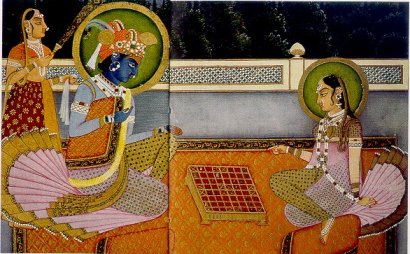 Krishna playing Chess against Radha (Miniature, XVIIIth century, National Mueum, New Delhi)
Krishna playing Chess against Radha (Miniature, XVIIIth century, National Mueum, New Delhi)
Often, the board presents several cross-cut squares which have no importance in the play. 8x8 board are known from very ancient times in India as they were used to play Ashtapada (But nothing firmly proves that Ashtapada board had cross-cut cells).
For many, India is the cradle of Chess. This question remains controversial, however the fascinating diversity of Chess in India gives this country a very special role.
 |
 |
 |
|---|---|---|
| Knight | Elephant or Rook | Knight |
Earliest Indian chessman known, dated end of 16th century. The 2 on left come from the Hindu Kingdom of Vijayanagar. Conserved at Victoria and Albert Museum, London.
The pieces are first named in India by Ratnakara in his Haravijaya (circa 850). But India is poor for archaeological findings and it is not before the end of the 16th century that the oldest piece is known.
The conjonctural name of the pieces in the primitive game are the following:
| Name | meaning | equivalent |
|---|---|---|
| Raja | King | King |
| Mantri | Minister | Queen |
| Hasty | Elephant | Bishop |
| Ashwa | Horse | Knight |
| Ratha | Chariot | Rook |
| Padah | Soldier | Pawn |
The name of the pieces are numerous and change from one region to an other. For instance, there are the following:
| Hindi | Marathi | Bengali | Telegu | equivalent |
|---|---|---|---|---|
| Raja | Raajaa | Raja | Raju | King |
| Vazir1, Rani2 | Vjiir1 | Mantri1, Rani2 | Mamtri1 | Queen |
| Umt3 | Untt3 | Hati6 | Shakatu4 | Bishop |
| Ghora5 | Ghoddaa5 | Ghora5, Na'ita | Gurram5 | Knight |
| Hathi6 | Httii6 | Nouka7, Ruka | Enugu6 | Rook |
| Pyada, Sainik | Pyaade | Bore, Pana | Bamtu | Pawn |
| Shatranj | Buddhibll | Daba | Chadarangam | Chess |
Name of pieces at several Indian languages(1) Minister, (2) Queen, (3) Camel, (4) Chariot, (5) Horse, (6) Elephant, (7) Boat
Here is a more complet table with Indian scripts names, in more languages. Download it! (pdf)
If you speak one or more languages from the Indian sub-continent, your help to correct or complete this table will be much appreciated. Please contact me.
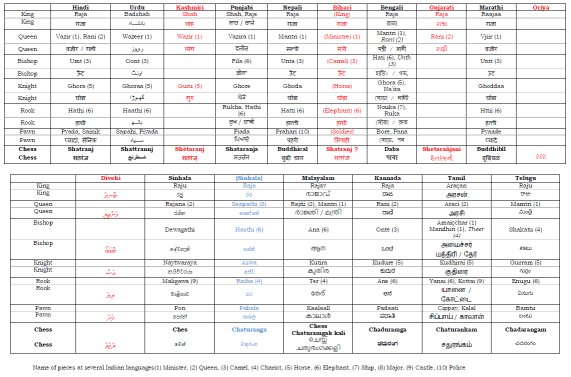
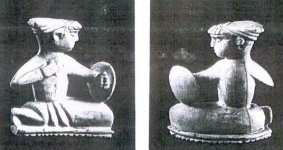
Bowman (Pawn?), North India (Rajasthan), 12-14th c.
Museum of Indian Art, Berlin
FIGURATIVE SETS
The royal animal in India is the elephant. Then, most representations of the Raja and the Mantri (King and Minister [our Queen]) are figured in palanquins on the back of an elephant.   Largest surviving group of Indian figurative chessmen. India, c. 1610, carved polychrome ivory. Very similar to the pieces described by Thomas Hyde (Ludis Orientalibus, 1694) Largest surviving group of Indian figurative chessmen. India, c. 1610, carved polychrome ivory. Very similar to the pieces described by Thomas Hyde (Ludis Orientalibus, 1694)  Hindu style from south India, circa 1790. (Ivory).The Chariot of this set is very similar to designs found in Burma. Hindu style from south India, circa 1790. (Ivory).The Chariot of this set is very similar to designs found in Burma.  A King, India, XVIII or XIX century. The set is conserved at Musée de Chartres, France. (Painted ivory). However, the original Elephant, as a chessman, was a very weak piece. The consequence was that its move was not fixed. Murray collected as many as three different moves for it among the numerous available plays in historical India: leaping to the 2nd square diagonally (the original move) leaping t the 2nd square orthogonally moving 1 step in diagonal or straight ahead (still in use at Sittuyin, Makruk and ... Shogi) Then, its position has always been loose on the chessboard. In some games, the Elephant and the Chariot exchanged their positions, in other games they exchanged their move, and finally, it happened that they exchanged both. Then, in many Indian sets, the Elephant is sitting at the board corners and is sliding orthogonally as our Rook. The Indians were very attracted by animal representation in chessmen. They had already Horses and Elephants, then they were inclined to substitute another animal to the Chariot. Sometimes it was a Rhinoceros, or a Buffalo, but most commonly it was a Camel (Unt or_Ushthra_). However, the Camel was generally not moving like the Arabic Chariot which orthogonal move was left to the Elephant, the most powerful animal. Rather, the Camel was jumping diagonally like the old Hasty. Later, under European influence, it got the sliding diagonal move of our modern Bishop. A King, India, XVIII or XIX century. The set is conserved at Musée de Chartres, France. (Painted ivory). However, the original Elephant, as a chessman, was a very weak piece. The consequence was that its move was not fixed. Murray collected as many as three different moves for it among the numerous available plays in historical India: leaping to the 2nd square diagonally (the original move) leaping t the 2nd square orthogonally moving 1 step in diagonal or straight ahead (still in use at Sittuyin, Makruk and ... Shogi) Then, its position has always been loose on the chessboard. In some games, the Elephant and the Chariot exchanged their positions, in other games they exchanged their move, and finally, it happened that they exchanged both. Then, in many Indian sets, the Elephant is sitting at the board corners and is sliding orthogonally as our Rook. The Indians were very attracted by animal representation in chessmen. They had already Horses and Elephants, then they were inclined to substitute another animal to the Chariot. Sometimes it was a Rhinoceros, or a Buffalo, but most commonly it was a Camel (Unt or_Ushthra_). However, the Camel was generally not moving like the Arabic Chariot which orthogonal move was left to the Elephant, the most powerful animal. Rather, the Camel was jumping diagonally like the old Hasty. Later, under European influence, it got the sliding diagonal move of our modern Bishop.  Elephant from a Mughal Chess set, India, late 17th to early 18th. Ivory, lacquer. The Metropolitan Museum Of Art(the upper part of the elephant's rider is missing) Elephant from a Mughal Chess set, India, late 17th to early 18th. Ivory, lacquer. The Metropolitan Museum Of Art(the upper part of the elephant's rider is missing)  Chess piece (Elephant?, Rook?), Rajasthan, India, possibly 18thCnetury. Ivory. Brooklyn Museum Of Art Chess piece (Elephant?, Rook?), Rajasthan, India, possibly 18thCnetury. Ivory. Brooklyn Museum Of Art  Rajasthan, circa 1840. Historisches Museum, Dresden. (Ivory). Rajasthan, circa 1840. Historisches Museum, Dresden. (Ivory).  A Sikh set, Punjab, circa 1890. Sikh in green against Chinese in white. (Ivory) A Sikh set, Punjab, circa 1890. Sikh in green against Chinese in white. (Ivory) |
|
|---|---|
 Set from Murshidabad, Bengal, representing a mogul army. (Ivory). Set from Murshidabad, Bengal, representing a mogul army. (Ivory). |
 Set from Berhampur, XIXth century Set from Berhampur, XIXth century |

Set from Jaipur, XIXth century. (Enameled silver with jewels)
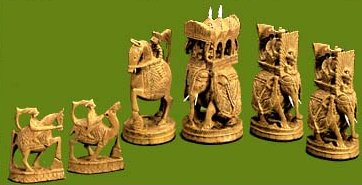
A contemporary Indian set, nowadays in sale in India.(Sandal wood).
In Bengal, a Boat was used instead of the Chariot. It is believed that this is due to a Muslim influence, the Arabic Rukh being assimilated to the Sanskrit Roka which means boat or ship. Also, the Muslim shape of the piece was like a V which reminds the hull of a ship. Bengali texts also name that piece Nauka (Ship).
Interestingly, a similar process occurred in the North-West when Chess was transmitted to Russia where the Rook is still a Ladya, a Boat. More directly, the Indian influence persisted in South-East Asia, in Siam (Thailand) and Cambodia.
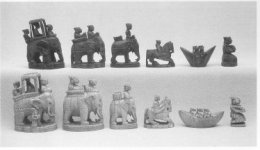
Bengal, XVII th century. (Ivory).
 |
 |
|---|
 |
 |
|
|---|---|---|
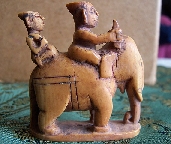 |
 |
 |
 |
 |
|
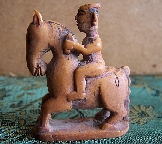 |
 |
|
 |
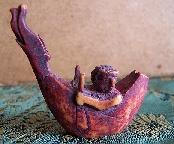 |
 |
 |
 |
 |
An ivory Indian set very similar to the Bengali set above. This one belongs to Ms Chandana Phukan. Apparently, 3 pieces on the red side (King, 1 Boat, 1 Pawn) are replacements of missing ones (Many thanks to Chandana Phukan and Doug Cook for their nice photographs)
ABSTRACT SETS
The Muslim influence is seen in the abstract sets. The chief difference with Muslim pattern in the shape of the Rook which evolved into a low piece with a flat top whereas in Arabic style it was a tall piece with a distinct head.
 Indian Muslim set, similar to the one depicted by Hyde in 1694. (Colored silver tin). Indian Muslim set, similar to the one depicted by Hyde in 1694. (Colored silver tin). |
 Another Muslim set, style of Lahore, Punjab, circa 1870. (Wood and ivory). Another Muslim set, style of Lahore, Punjab, circa 1870. (Wood and ivory). |
|---|---|
 |
 |
Modern (in 1913) Indian sets, Muslim style (from Murray)

Mughal period, 17th or 18th c., citrine. From right to left: Pawn, Rook, King, Vizier, Elephant, Horse

Indian Muslim set, ivory, 18th c.









